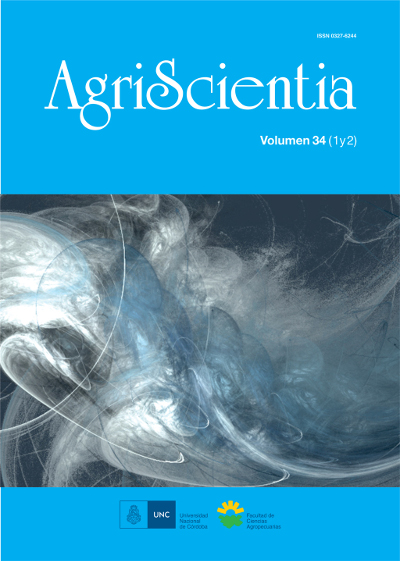Evaluation of technological, nutritional and sensory quality of cereal bars with quinoa.
Main Article Content
Abstract
Quinoa seed (Chenopodium quinoa Willd) is characterized by a balanced composition, rich in proteins, fiber, vitamins, minerals and antioxidants; so, it can be incorporated into the formulation of cereal bars in order to increase the nutritional value of the daily diet. Therefore, the objective of this work was to study the effect of quinoa seed incorporation on the technological, nutritional and sensory quality of cereal bars. Three samples of cereal bars were prepared with different percentages of substitution of crispy rice with quinoa seeds and a control (without addition of quinoa). An increase in weight and a decrease in he length of the cereal bars were observed, as the level of quinoa increased
in the formulation. The hardness of the bars was affected, obtaining softer
bars when they had quinoa in their formulation. The incorporation of quinoa generated an increase in the content of minerals, proteins and dietary fiber of the final product. In addition, the quinoa cereal bars showed a slower starch digestibility. Consumers liked the taste of quinoa bars and they also had good overall acceptability.
Downloads
Article Details
References
Abugoch, L., Romero, N., Tapia,C.,Silva, J. yRivera,M.(2008). Study of some physicochemical and functional properties of quinoa (Chenopodium quinoa Willd) protein isolates. Journal of Agricultural of Food Chemistry 56(12), 4745-4750.
Alvarez-Jubete, L., Arendt, E. K., y Gallagher, E. (2010).Nutritive value and chemical composition of pseudocereals as gluten-free ingredients.International Journal of Food Science and Nutrition 4, 240-257.
Ao, Z.; Simsek, S., Zhang, G.,Venkatachalam, M.,Reuhsand, B. L.,Hamaker, B. R.(2007). Starch with a slow digestion property produced by altering its chain length, branch density and crystaline structure. Journal of Agricultural Food Chemistry 55 (11), 4540-4547.
Brennan, C.S.,Blake,D.E., Ellis, P.R.ySchofield,J.D. (1996). Effect of guar galactomannan on wheat bread microstructure and on the in vitro and in vivo digestibility of starch in bread.Journal of Cereal Science, 24, 151-160.
Bustos, M. C., Pérez, G. T.yLeón, A. E(2011). Sensory and nutritional attributes of fibreenriched pasta.LWT –FoodScience and Technology 44, (6,), 1429-1434.
Di Rienzo, J. A., Casanoves, F., Balzarini, M. G., Gonzalez, L., Tablada, M., y Robledo, Y. C. (2011). InfoStat versión 2011. Grupo InfoStat, FCA, Universidad Nacional de Córdoba, Argentina. URL http://www. infostat. com. ar
Englyst, K.N.,Englyst, H. N., Hudson, G. J., Cole, T. J.yCummings, J. H.(1999). Rapidly available glucose in foods: an in vitro measurement that reflects the glycemic response. The American Journal of Clinical Nutrition, 69, 448-454.
WHO (1985).Energy and Protein Requirements.Report of a joint FAO/WHO/UNU expert consultation.WHO Technical Report, Series, N° 724.
Farinazzi-Machado, F.M.V., Barbalho, S. M.,Oshiiwa, M.,Goulart, R. yPessan Junior, O. (2012).Use of cereal bars with quinoa (Chenopodiumquinoa W.) to reduce risk factors related to cardiovascular diseases.Ciência e Tecnologia de Alimentos 32(2), 239-244.
Gelencsér, T.,Gál,V.,Hódságiand, M. ySalgó,A.(2007). Evaluation of quality and digestibility characteristics of resistant starch-enriched pasta.Food Bioprocess Technology1(2),171-179.
Jacobsen, S.E.,Mujica, A.yJensen,C.R.(2003).The resistance of quinoa (Chenopodium quinoa Willd) to adverse abiotic factors.Food Reviews International 19(1-2), 99-109.
Jacobs, D.R.,Marquart, L.,SlavinJ.yKushi, L. H.(1998). Whole-grain intake and cancer: an expanded review and meta-analysis. Nutrition and Cancer30(2), 85-96.
Kasum, C.M., Jacobs, D. R., NicodemusK.yFolsom A. R.(2002). Dietary risk factors for upper aerodigestive tract cancers.International Journal of Cancer 99(2), 267-272.
LEY No 18284, Código Alimentario Argentino, Capítulo V, artículo 235 quinto. Resolución GMC No 01/02 (incorporada por Resolución Conjunta SPReI No 161/2013 y SAGyP No 213/2013), Reglamento técnico Mercosur sobre “Información nutricional complementaria (declaraciones de propiedades nutricionales)”. Apartado 5 “Condiciones para declarar información nutricional complementaria (declaraciones de propiedades nutricionales)”. Subapartado 5.2 “Contenido comparativo”. Recuperado de: http://www.alimentosargentinos.gob.ar/HomeAlimentos/Marco_Regulatorio/ultimas%20modificaciones/Capitulo_V.pdf
Meyer, K.A.,Kushi, L. H., Jacobs, D. R.,Slavin, J. R., Sellers, T. A.yFolsom, A. R.(2000). Carbohydrates, dietary fiber, and incident type 2 diabetes in older women. The American Journal of Clinical Nutrition 71(4),921-30.
Navruz-Varli, S. ySanlier, N.(2016).Nutritional and health benefits of quinoa (Chenopodium quinoa Willd).Journal of Cereal Science 69,371-376.
Nowak, V., Du, J. U.yCharrondière, R.(2015).Assessment of the nutritional composition of quinoa (Chenopodium quinoa Willd).Food Chemistry 193, 47-54.
Stanley, D.W. (1986). Chemical and structural determinants of texture of fabricated foods. FoodTechnology, 12,65-76.
Repo-Carrasco, R.,Cortez,R.O.M., Quispe, V. y Ramos,I.(2006). “Cultivos Andinos”, en León, E. y Rosell, M.C. De tales harinas, tales panes. Granos, harinas y productos de panificación Iberoamericana (pp. 245-294). Córdoba, Argentina.Editorial ISEKI-Food.Singh, J.,Dartois, A.yKaur,L.(2010). Starch digestibility in food matrix: a review. Trends in Food Science and Technology21,168-180.
Steffolani, M. E., Leon, A. E. y Perez, G. T. (2013). Study of the physicochemical and functional characterization of quinoa and kañiwastarches.Starch/Stärke 65(11-12),976-983.
Steffolani, M.E.,Villacorta,P., Morales-Soriano,E.R.,Repo-Carrasco,R., León, A.E.yPérez, G. T.(2016). Physicochemical and Functional Characterization of Protein Isolated from Different Quinoa Varieties (Chenopodiumquinoa Willd).Cereal Chemistry 93(3), 275-281.
Vega-Gálvez, A., Miranda, M.yVergara, J.(2010).Nutrition facts and functional potential of quinoa (ChenopodiumquinoaWilld), an ancient Andean grain: a review. Journal of the Science of Food and Agriculture 90(15), 2541-2547.
Wang Shujun, Li Caili, Copeland Les, Niu Qing yWangShuo(2015). Starch Retrogradation: A Comprehensive Review. Food Science and Food Safety14(5), 568-585.
Willett, W., Manson, J.yLiu, S.(2002).Glycemic index, glycemic load and rick of tipe 2 diabetes.American Journal of ClinicalNutrition 76(1), 274-280.





